Think back on your school years: did you attend most classes and spend a lot of time with your classmates?
That’s the power of cohort-based learning, where a group of students go through the same lessons at the same time and learn together.
One of the big promises of online learning was that making all the lessons available for students to take at their own pace, would free up teachers to do other work, like reviewing assignments or giving feedback.
But what we’ve learned from putting self-paced learning online in Massive Open Online Courses (MOOCs) is that most self-paced online courses have completion rates of 3-15%.
If your business model depends on making sales of your online courses, then you want more students to succeed so they will purchase more courses or recommend your courses to their friends.
What Are Cohort-Based Courses?
Chances are you’ve already taken part in cohort courses without even realizing it. It’s a type of learning experience where students go through course content at the same pace. Some lessons may be taught live, some may be available to watch in students’ own time. There’s also often a way for group members to communicate and learn together online.
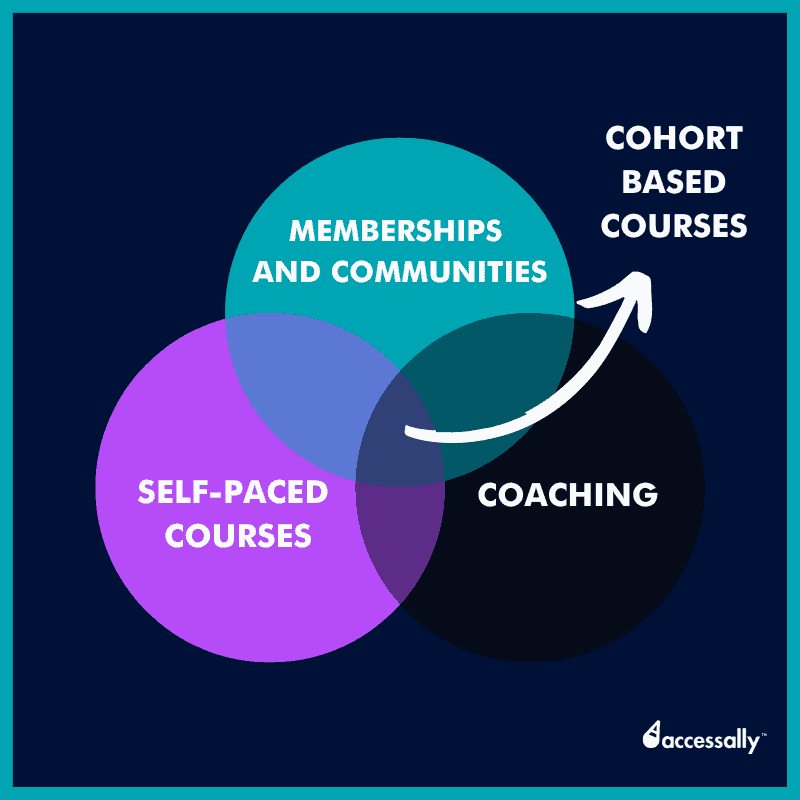

Cohort-Based Courses vs. Self-Paced Courses vs. Ongoing Membership Programs
The most common type of online program in a virtual environment tends to be the type of on-demand training that is pre-recorded.
Self-paced online courses are often a collection of videos, audios, downloadables, and text-based training. Self-paced courses are housed in an online portal or could be downloadable or through an app.
A student comes in and can move through the material as fast or slow as they need to.
The benefits: it’s great for busy people who need to squeeze their learning into their own timetable. It’s easy enough for course creators to put together and automate, which reduces the time involved from the coach or teacher.
The drawbacks: the completion rate for self-paced courses is so low (3-15%) that most people who sign up for these courses never finish them.
Now let’s look at ongoing membership programs, which might include self-paced online education courses but also usually has a community component and some live ongoing facilitation.
Often a recurring membership program will have a forum or other community area for students to get to know each other, and encourage each other along their journeys. The benefit of an ongoing membership is that you will have more established students who can help onboard and support new students.
There are also often live coaching or live Q&A sessions that can happen on a monthly or weekly basis for all active members to attend.
These live sessions offer a lot of value and can also keep people motivated and getting results after their initial excitement might wear off in a self-paced course.
The benefits: one major benefit of a membership program is that you can earn a recurring income as the organizer. You can also keep building up your member base and grow a stable business.
The drawbacks: the downside is you need to continue to nurture your community, add new members, and possibly keep adding more training. The long-term commitment makes this a good option for more established businesses rather than a start-up coach or trainer.
Now we can look at cohort-based learning and see that this type of training can be an amazing “best of both worlds”.
Cohort-based courses are where you may include some video and audio training materials, but they release these to an entire group of students at the same time. These can also be called hybrid courses.
You might also have a community component like with a membership through a forum or chat program. The difference is that each student starts from the same place as a new member.
Another key in cohort-based courses is the live facilitation element, where you might host a weekly call or zoom session to teach or answer questions.
Some cohort-based courses separate the training from the live calls, so the training can be self-paced on a schedule (people can’t rush ahead).
Now let’s take a more in-depth look at the pros and cons of cohort-based learning.
5 Reasons to Use Cohort-Based Learning in Your Training Programs
First, let’s look at the benefits of cohort-based courses for course creators and coaches.
1. When students succeed, you get more testimonials
The biggest benefit from students completing your courses and getting the results they were after is that you’ll get more happy testimonials.
With more testimonials and feedback, you can continue to improve your course delivery and also sell the course more confidently.
By adding these happy student testimonials to your online course sales page, you’ll keep attracting more of your ideal students.
2. With live cohort-based courses, you can sell with real urgency
We all understand the psychological principle that deadlines get people to decide, whether that is to sign up for a course or not.
Many evergreen course creators have a hard time creating authentic deadlines to get people to sign up.
They may use expiring coupons or countdown timers, but as people become savvier, they will know that they can just reset the timer if they sign up with another email address or visit from another browser.
With cohort-based courses, you have a proper start and end time for your course. So you can market around your start date and have a genuine sense of urgency in your campaign.
If someone misses this enrollment window, they will need to wait until the next live cohort round to sign up. That can help increase sales and even build up a waiting list of interested course participants if they miss this upcoming cohort.
3. You can charge more for cohort courses that are live
People have different expectations around go-at-your-own-pace courses and live courses, and that can be reflected in the price you can charge.
Because of the time investment of the course creator and teacher being more present in a cohort-based course, people understand they will be paying a premium for this access.
You can also justify a higher price by showcasing the difference between your cohort-based course and hiring you for 1-1 coaching. In this light, your cohort-based course feels like an easy decision investment, because they still get access to you as the facilitator, but they also get the community aspect, which is worth a lot.
Now let’s look at the benefits of cohort-based courses for the students participating in the online courses.
4. More engagement and learning
Some studies have shown that cohort-based learning completion rates are closer to 80%. This is a staggering increase compared to self-paced courses that come in at completion rates of less than 15%.
Why is cohort-based learning so much more effective?
It’s because of the built-in accountability. Whether you decide to assign accountability buddies or help people pair up with other students or not, there’s an inherent sense that everyone is in it together.
That means students want to keep up and will do their best to move through the lessons and attend the live training sessions.
They know they get “what they put into it,” and there might also be an end date for the course. This motivates people to get through the material before the time to ask their questions is up.
5. The connections with the community
There’s a lot of networking that happens in a live cohort-based course.
Some course participants even sign up for courses to get “in the room” with people they wouldn’t otherwise have access to, even if it’s only virtually.
For example, many people believe that some of the biggest benefits of attending prestigious universities are not so much the teaching but the network that people have at their fingertips upon graduation.
Often, students will say that the other people taking the course with them were as instrumental in the results they got as the teacher or course leader.
That’s a great thing because it takes the pressure off the coach or course leader to be the only person who can answer questions or help people.
It also can create ripple effects as students go off into the world and create partnerships or become real-world friends from the course.
How to create cohort-based courses
Now that you know the benefits of cohort-based courses when compared to evergreen or self-paced ones, let’s look at how to create them.
The first step is to decide what part of your course will be available independently and what you will teach live.
You might decide if you’re doing a course pre-sale (highly recommended, here’s the book that shows you how) that you will deliver the entire course through live sessions that will be available as recordings later.
If you decide to go that route, you can then edit your live recordings or re-record just the teaching parts to turn them into content that students can watch before attending future video calls.
The first time you deliver your live course, you might not cover the topic in a way that answers all of your students’ questions. That’s normal.
You’ll get feedback from live students and be able to improve on your next delivery.
1. Outline your course curriculum
No matter what learning model you choose, you will want to design a clear structure for your course material.
In the book Making Learning Whole by David Perkins, we learn that it’s helpful for student success if we give the big picture and actionable information right in the first module.
Then each successive module or lesson can provide a deeper understanding, as individuals advance through the course material.
The biggest takeaway here? Don’t hold back your best educational content until the end, because students can benefit from it earlier on. This also demonstrates to students that you can help them get to their destination fast, which can set your course apart from others out there.
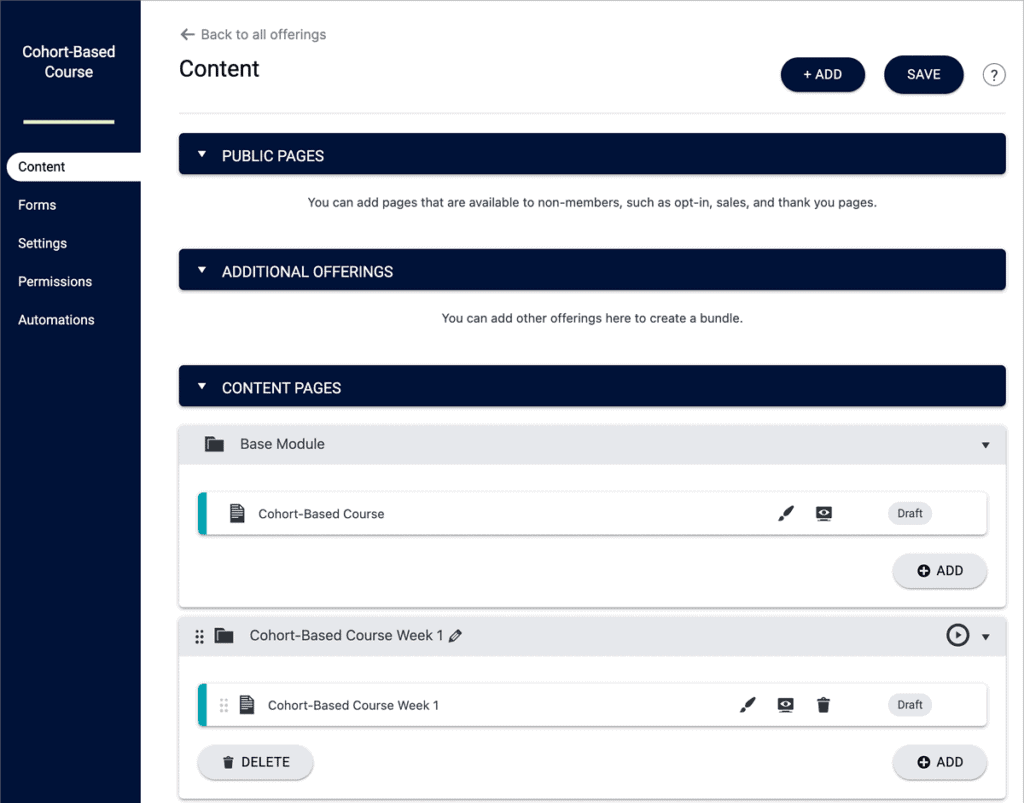

2. Set up your online environment
Now that you have your course content or at least some of it ready, you can start to set up the technology that will deliver your learning experience to students.
There are a few online course platforms that cater to cohort-based learning, and the one we’ll be using as an example today is called AccessAlly. It’s a WordPress plugin that handles cohort-based programs from enrollment to delivery and can give you the cohort learning environment you’ve been looking for.
You’ll want to set up your online course structure in the drag-and-drop builder.
You can also start uploading videos and other content to the pages of the portal.
Now it’s time to set up the enrollment pages.
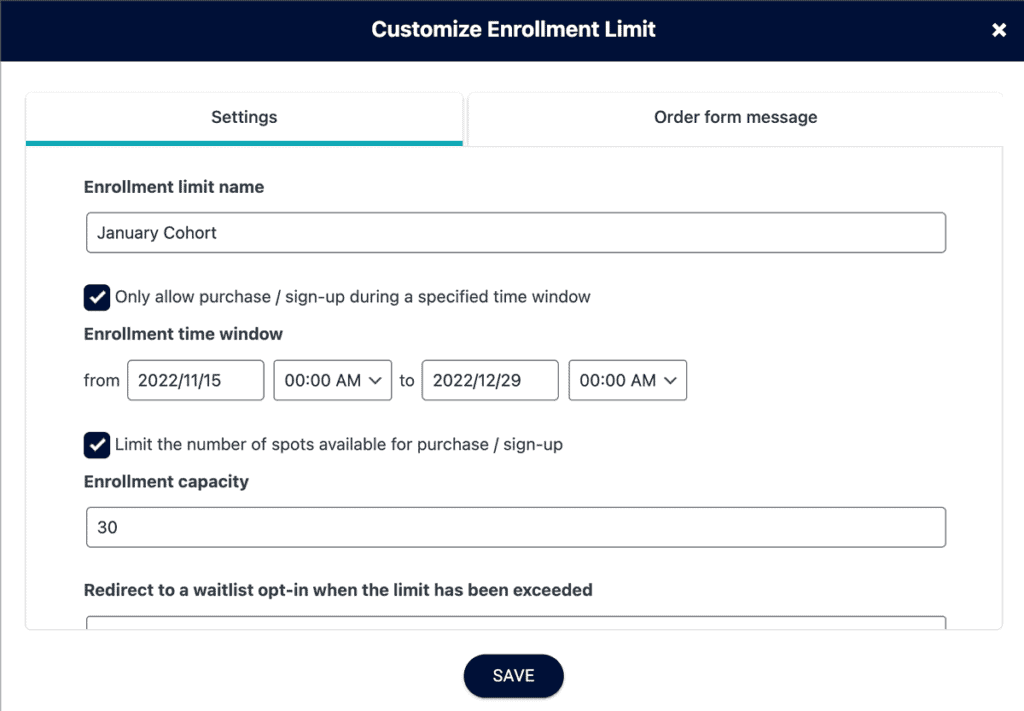

3. Create your cohort enrollment page
With AccessAlly you can create cohort-based online courses with just a few clicks. You can decide how you want to run your cohorts:
- Start and close course enrollment on specific dates
- Or, limit the enrollments by the number of students
- Or both
When your parameters are reached, your course’s order form will automatically turn into a waiting list page that collects people’s email addresses. This way you can follow up with potential students who missed this cohort, so they can join the next round.
This way, you can link to your order form from your course sales page and not have to worry about updating your sales page or website at the exact time that enrollment closes.
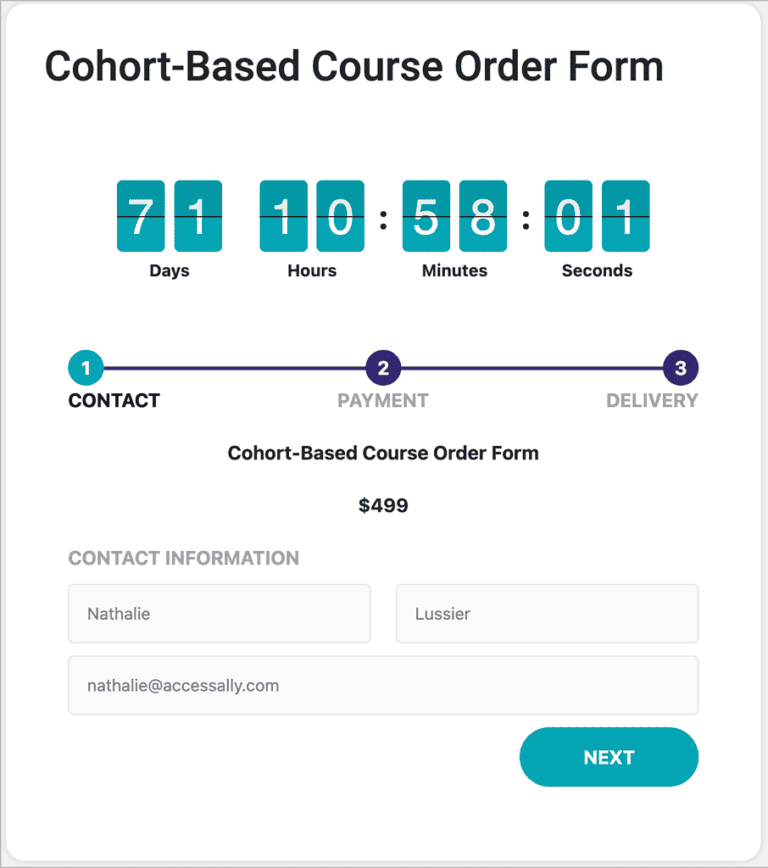

4. Send welcome emails and kick off the training
Now you’ll email the entire cohort and officially start the student experience. The key difference here is that everyone gets the same emails at the same time, so everyone can stay on track.
You’ll show the schedule of live classes in your members-only area, which mirrors how traditional education works.
Then students can join the video calls or watch the replays if the timing doesn’t work out for them.
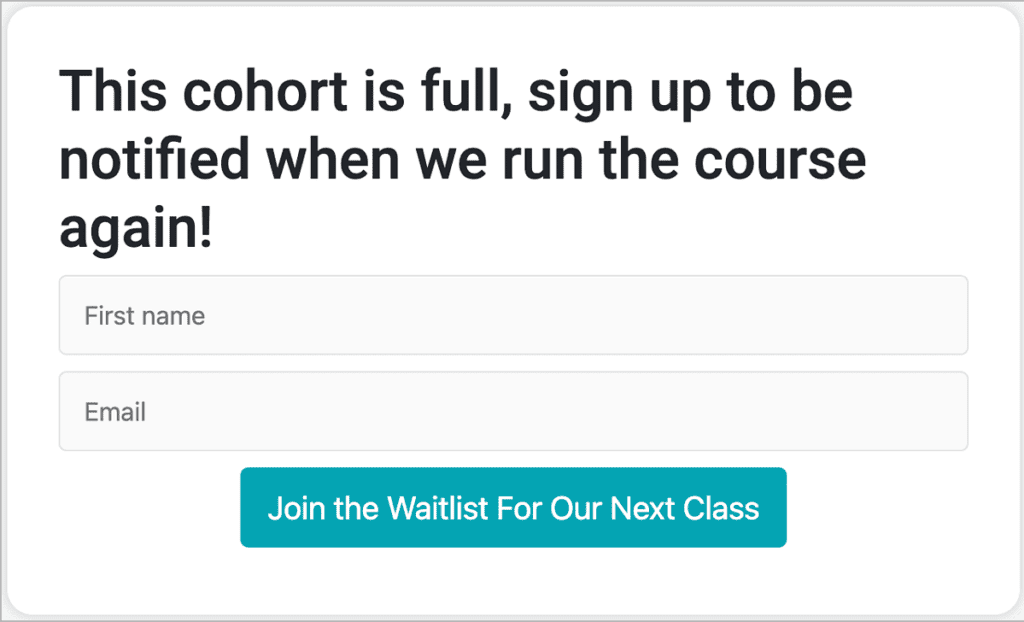

5. Encourage group discussion through community building
The cohort-based learning model benefits so much from the interaction between students, so use CommunityAlly to create the perfect place for cohort members to get to know each other.
Unlike a physical classroom, students don’t know who else is in the program unless you as the facilitator make an effort to build up these connections.
A private community that gives group members prompts and ways to develop deeper understanding by talking about what their learning is the key to student success.
You can also create smaller groups or ask people to collaborate on group work projects to show that they are achieving the learning outcomes you’ve set out for them.
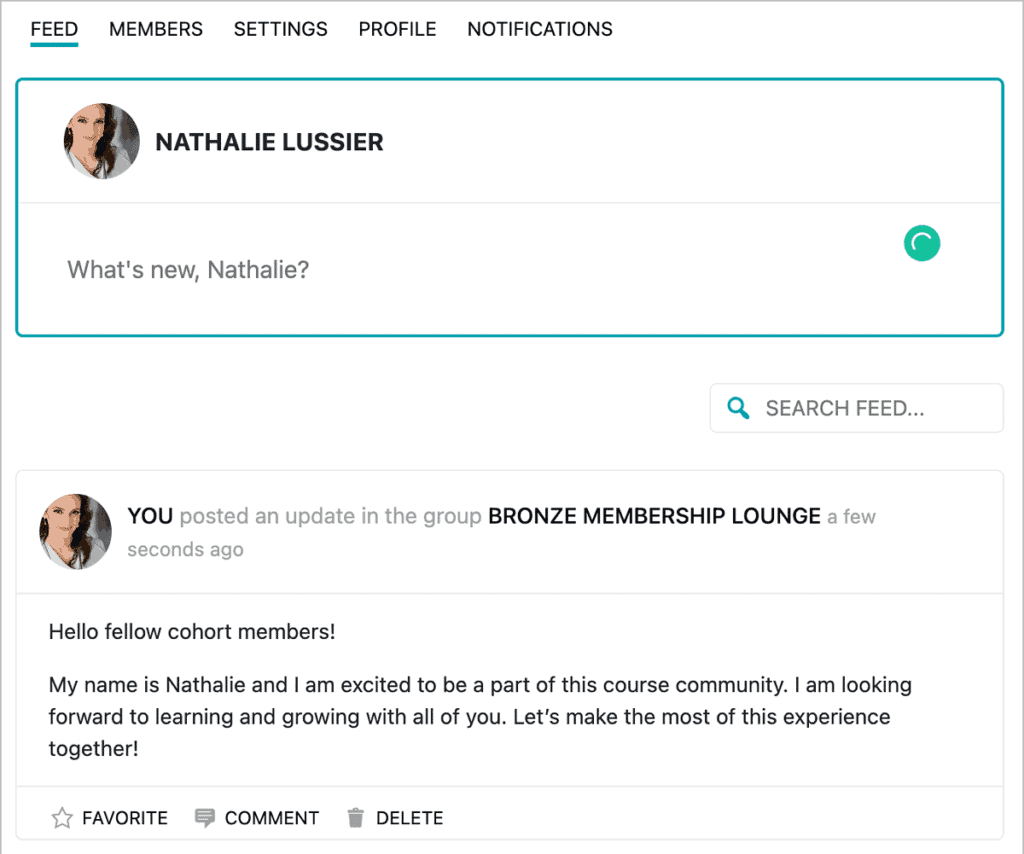

What happens when someone gets behind?
With a cohort-based course platform like AccessAlly, you can easily see when students are falling behind.
It happens for several reasons, and it’s normal for people to get busy and not be able to keep up with the pace of the course.
You can help these students catch up with the course material by sending them a reminder email or giving them an overview of what they need to know, so they can keep going with the rest of the class.
You can also remind people who fall behind that they are still gaining many benefits from attending live video calls and taking part in your community.
Some course creators choose to add “implementation weeks” or “catch-up breaks” during their course delivery so that when the inevitable circumstances pop up for students, they can get back on track.
Get started with cohort-based learning
If this article gave you some new ideas to help make your online learning more effective, then make sure you check out AccessAlly, because it can replace all the tools you would usually need to buy separately, like your shopping cart, course delivery, email platform, and community tool.


